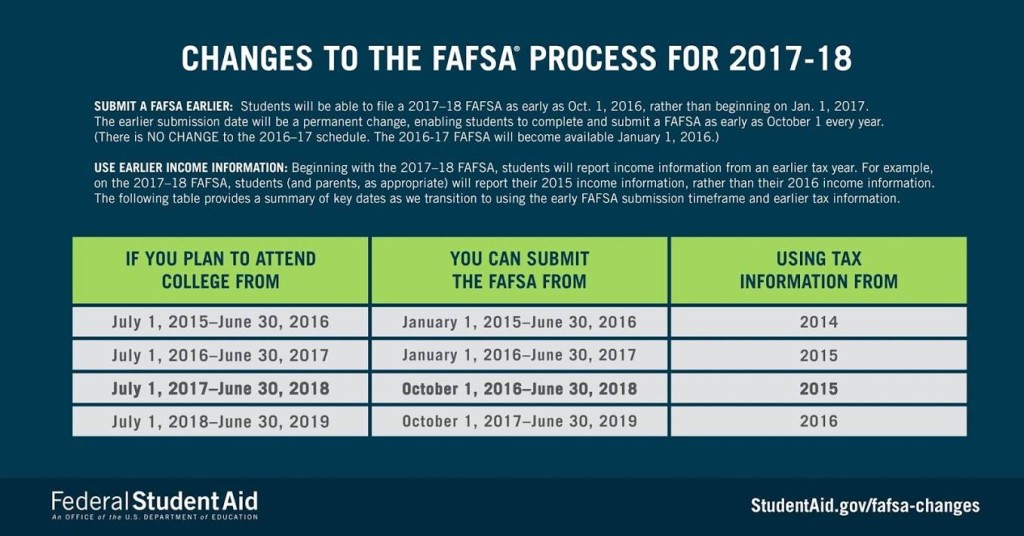 President Obama is working on removing barriers to students obtaining financial aid for which they qualify. Changes to the FAFSA filing period’s submission date will make the application process faster, easier and enable students to get earlier financial aid award notification. This will provide graduating (and transfer) students with valuable information they can use to help identify the best college match.
President Obama is working on removing barriers to students obtaining financial aid for which they qualify. Changes to the FAFSA filing period’s submission date will make the application process faster, easier and enable students to get earlier financial aid award notification. This will provide graduating (and transfer) students with valuable information they can use to help identify the best college match.
The transition means that:
- For the 2017-18 school year, students can submit the FAFSA as early as October 1, 2016 (two months ahead of the current submission date).
- Students will submit their 2017-18 school year FAFSAs with year 2015 financial information.
- 2017-18 school year is the first year that “prior-prior” (in other words, 2 years back) financial information for parents and student will be used for the FAFSA.
- Most parents and students will be able to use the IRS automatic retrieval tool to import tax return information directly into the FAFSA without needing to type it in (because 2015 tax returns filed by April 15, 2016 will have been processed by October 1, 2016).
- PELL grant award information will become available to graduating high school students (and college transfer students) months earlier in the college application process. This will aid families in selecting a school that offers the right combination of academic and financial opportunity for the student.
- In order to accommodate the new FAFSA submission date, filing students will fill out two FAFSAs in calendar year 2016:
- The school year 2016-17 FAFSA after the old submission opening date on January 1, 2016;
- The school year 2017-18 FAFSA after the new submission opening date on October 1, 2016. (See chart above.)
- Year 2015 financial information will be used for both the 2016-17 school year and the 2017-18 school year. (See chart above.)
- Year 2016 financial information will be used for the 2018-19 school year FAFSA. (See chart above.)
From the Federal Student Aid website:
On Sept. 14, 2015, President Obama announced significant changes to the Free Application for Federal Student Aid (FAFSA®) process that will impact millions of students. Starting next year, students will be able to do the following:
Submit a FAFSA® Earlier: Students will be able to file a 2017–18 FAFSA as early as Oct. 1, 2016, rather than beginning on Jan. 1, 2017. The earlier submission date will be a permanent change, enabling students to complete and submit a FAFSA as early as October 1 every year. (There is NO CHANGE to the 2016–17 schedule, when the FAFSA will become available January 1 as in previous years.)
Use Earlier Income Information: Beginning with the 2017–18 FAFSA, students will report income information from an earlier tax year. For example, on the 2017–18 FAFSA, students (and parents, as appropriate) will report their 2015 income information, rather than their 2016 income information.
Here are some key benefits the change offers:
..the President (announces) a new initiative to allow students and families to apply for financial aid earlier – starting in October as the college application process gets underway – rather than in January. In addition, students filling out the FAFSA will be able to electronically retrieve tax information filed for an earlier year, rather than waiting until tax season to complete their applications. Learning about aid eligibility options much earlier in the college application and decision process will allow students and families to determine the true cost of attending college – taking available financial aid into account – and make more informed decisions. Together with the new College Scorecard – which is redesigned with direct input from students, families, and their advisers to provide the clearest, most accessible, and most reliable national data on cost, graduation, debt, and post-college earnings – students will have more information to choose the right college than ever before.
The President will also announce complementary efforts to make sure students see the full benefits of the earlier FAFSA timeline to improve their access to college and help them make better college choices. Colleges and universities and scholarship organizations have already committed to align their aid timelines with the earlier FAFSA, and nonprofits and advisers have committed to raise awareness about the FAFSA changes and to help reach 100 percent FAFSA completion. Finally, the President will renew his call on Congress to pass legislation to simplify FAFSA even further by eliminating up 30 questions that are disproportionately burdensome and have little impact on aid eligibility.

One Reply to “Obama’s FAFSA filing date change will make student aid application process easier and more helpful”